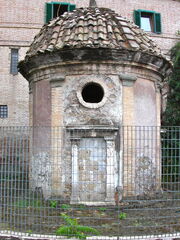Cappella di Reginald Pole is a small round deconsecrated 16th century chapel just by the Tomb of Priscilla, further along the Via Appia Antica from the church of Domine Quo Vadis and by the junction with the Via della Caffarella at number 57. This is in the Appio Latino quarter.
History[]
The chapel was built in 1539 by Cardinal Reginald Pole of England, who was in exile at Rome after the English King Henry VIII had rejected the authority of the Pope.
There are three alternative stories for the motivation for its erection:
The king had sent assassins to eliminate the cardinal, and the chapel was in thanksgiving for the failure of an attempted ambush at the site.
Or, that the cardinal thought that the church of Domine Quo Vadis was in the wrong place, and that Christ met St Peter fleeing Rome further down the Via Appia (this seems an unlikely motivation).
Or, that the chapel was to mark the point where the city dignitaries had met Emperor Charles V on his visit to Rome in 1536.
The chapel became the property of the English College, but was abandoned by the start of the 20th century.
It is now apparently a sanctuary for bats, and is in fairly sound condition. There is no access -it is surrounded by a security fence.
Appearance[]
This is a little cylindrical building, built from rubble which was rendered with stucco, and is modelled on an ancient Roman tomb.
There are eight Doric pilasters in yellow brick with granite plinths and capitals, dividing the wall into eight equally sized zones. These pilasters support an entablature in travertine limestone, and

Has a security fence (2011).
above this is a domed tiled roof which fits onto the projecting cornice. At the top of every other zone is a round window edged in yellow brick. There are doorways in two of the zones, facing at right angles to each other, and each of these has a flanking pair of Doric pilasters supporting an entablature with a projecting cornice, all in travertine.
Although this edifice is referred to as a chapel, it looks more like a casula or a devotional shrine than a place in which Mass might have been said. It resembles San Giovanni in Oleo in style and layout, especially in having two doorways (although here they are at an angle). These would expedite a queue of pilgrims waiting to venerate some object of devotion.
After the building fell into dereliction, the doors were walled up with cemented blocks. Beforehand, it contained paintings of the 16th century.